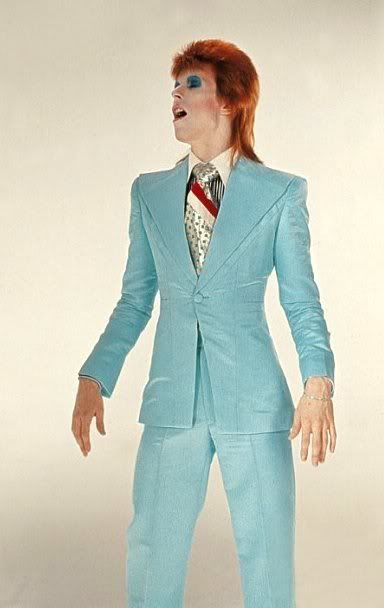
Singer David Bowie attends the Vanity Fair 2007 Tribeca Film Festival Party at the Courthouse on April 24, 2007 in New York City.
Born:
January 8, 1947, Brixton, London, England
Fan of: Bob Dylan, Andy Warhol, Velvet Underground, dramatic arts
Also Known As: Ziggy Stardust, The Thin White Duke
Net Worth: $900+ million Beginnings.
Calling David Bowie a fashion icon is not only cliche but perhaps one of the biggest understatements in this entire series of Fashion Influentials. Bowie has influenced so many people over such a long period (five decades and counting), that those he influenced are now influencing people, making him one of the few (only?) iconic figures in the realm of popular culture to transcend multiple genres while at once remaining confident and true to his image as a vibrant and imaginary innovator. Bowie’s initial meteoric impact stuck earth in the form of 1969’s “Space Oddity,” a mini-melodrama that faired well on the UK charts. Even bigger was the introduction in 1972 of his alter ego, Ziggy Stardust, an androgynous, glittery, wildly colorful persona that, though relatively short-lived, marked Bowie as the revolutionary trendsetter for which he would later be celebrated.
Career Highs.
The song “Fame” from his album, Young Americans, is widely credited as his big American cross-over work. But it wasn’t until 8 years later that Bowie hit major commercial pay dirt with the album Let’s Dance which produced three top 10 singles: “Let’s Dance,” “China Girl,” and “Modern Love.” Fashion-wise, though always two steps ahead of everyone else, you can trace Bowie’s highest and most impactful stylistic achievement to his second alter-ego, 1976’s “The Thin White Duke.” Two words: White. Suits.
“I write about misery.”
 Bowie, circa 1974.
Career Lows.
Bowie, circa 1974.
Career Lows.Oddly, during a period of great success in terms of crowd appeal and record sales (read: the mid 1970s), it was largely believed that the englittered glam rocker was quite zonked on the cocaine. Bowie says that he was introduced to the drug in America and evidence of addiction to it manifested on two occasions in particular. One, on The Dick Cavett Show in December 1974 and another in the documentary called Cracked Actor (shot in 1974, aired in 1975) that showed an emaciated, jittery singer nervously sniffing in the backseat of a car. Bowie would later comment that the album he made during that period should have been called, “David Bowie Is Alive and Well and Living Only In Theory.”
Legacy.
Someone once tried to compare Madonna to David Bowie claiming that both were successful in transforming their image on a dime and doing so effortlessly. I agree they both have been able to do so easier than most but the main difference is that Bowie’s style and trendsetting comes from a different place. Madonna seems to adopt a new look when she has an album coming out, Bowie’s sense of style seems to come from somewhere else, somewhere deeper. On Bowie, he’s just as likely to wear an outfit to dinner that he’s wear on stage. I think that’s a huge distinction.
 Bowie with his wife, Iman.
Get the look.
Bowie with his wife, Iman.
Get the look.Dressing like David Bowie is easy. Wearing clothing like Bowie is nearly impossible. You can easily buy a well-tailored white suit or just an amazing grey suit with a great white shirt and cuff links but it’s the way Bowie wears his clothes that makes it. If you can find a way to pull off his confidence while at the same time his nonchalance, you’ll be famous some day soon.
没有评论:
发表评论